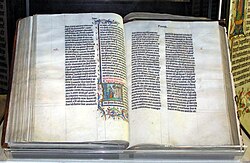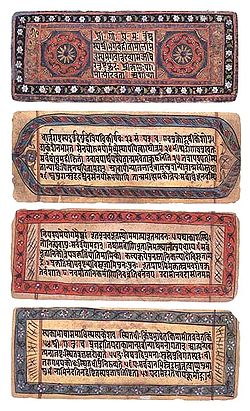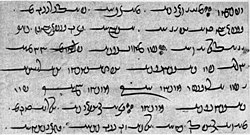This is an old revision of this page, as edited by Kbh3rd (talk | contribs) at 02:23, 12 March 2009 (Reverted edits by 24.28.13.17 (talk) to last version by SmackBot). The present address (URL) is a permanent link to this revision, which may differ significantly from the current revision.
Revision as of 02:23, 12 March 2009 by Kbh3rd (talk | contribs) (Reverted edits by 24.28.13.17 (talk) to last version by SmackBot)(diff) ← Previous revision | Latest revision (diff) | Newer revision → (diff) "Scripture" redirects here. For other uses, see Scripture (disambiguation).Religious texts, also known as scripture, are the texts which various religious traditions consider to be sacred, or of central importance to their religious tradition. Many religions and spiritual movements believe that their sacred texts are divinely or supernaturally inspired.
History of religious texts
See also: history of religion, timeline of religion, and history of writingThe oldest known religious texts are Pyramid texts of Ancient Egypt that date to 2400-2300 BCE. The Epic of Gilgamesh from Sumeria is also one of the earliest literary works dating to 2150-2000 BCE, that includes various mythological figures . The Rigveda of Hinduism is proposed to have been composed between 1700–1100 BCE making it possibly the world's oldest religious text still in use. The oldest portions of the Zoroastrian Avesta are believed to have been transmitted orally for centuries before they found written form, and although widely differing dates for Gathic Avestan (the language of the oldest texts) have been proposed, scholarly consensus floats at around 1000 BCE.
The first scripture printed for wide distribution to the masses was The Diamond Sutra, a Buddhist scripture, and is the earliest recorded example of a dated printed text, bearing the Chinese calendar date for 11 May 868 CE.
Views
Attitudes to sacred texts differ. Some religions make written texts widely and freely available, while others hold that sacred secrets must remain hidden from all but the loyal and the initiate. Most religions promulgate policies defining the limits of the sacred texts and controlling or forbidding changes and additions. Some religions view their sacred texts as the "Word of God", often contending that the texts are inspired by God and as such not open to alteration. Translations of texts may receive official blessing, but an original sacred language often has de facto, absolute or exclusive paramountcy. Some religions make texts available free or in subsidized form; others require payment and the strict observance of copyright.
References to scriptures profit from standardisation: the Guru Granth Sahib (of Sikhism) always appears with standardised page numbering while many other religions (including the Abrahamic religions and their offshoots) favour chapter and verse pointers.
Other terms
Other terms are often by adherents to describe the canonical works of their religion. In the United States, terms like 'Holy Writ' and others are used by some Christian groups (including the King-James-Only Movement) to describe the Christian Bible or, less often, by Muslim groups to describe the Qur'an.
Another term is 'Holy Scripture' or 'Sacred Scripture', used to denote the text's importance, its status as divine revelation, or, as in the case of many Christian groups, its complete inerrancy. Christianity is not alone in using this terminology to revere its sacred book; Islam holds the Qur'an in similar esteem, as does Hinduism the Vedas and Bhagavad Gita, and Buddhism the sutras.
Hierographology
Hierographology (Greek ιερος, hieros, "sacred" or "holy", + γραφος, graphos, "writing", + λογος, logos, "word" or "reason") (archaically also 'hierology') is the study of sacred texts.
Increasingly, sacred texts of many cultures are studied within academic contexts, primarily to increase understanding of other cultures, whether ancient or contemporary. Sometimes this involves the extension of the principles of higher criticism to the texts of many faiths. It may also involve a comparative study of religious texts. The hierographology of the Qur'an can be particularly controversial, especially when questioning the accuracy of Islamic traditions about the text.
List of sacred texts of various religions
Ásatrú
- The Poetic Edda, especially including the Hávamál
- The Younger Edda
Ayyavazhi
- The Akilattirattu Ammanai
- The Arul Nool
Bahá'í Faith
- The Kitáb-i-Aqdas
- Kitáb-i-Íqán
- and many other writings including ones from other faiths
Bön
Buddhism

- Theravada Buddhism
- The Tipitaka aka Pali Canon
- East Asian Mahayana
- The Chinese Buddhist Tripitaka, including
- Diamond Sutra
- Pure Land Buddhism
- Infinite Life Sutra
- Amitabha Sutra
- Contemplation Sutra
- other Pure Land Sutras
- Tiantai, Tendai, and Nichiren
- Shingon
- The Chinese Buddhist Tripitaka, including
- Tibetan Buddhism
Christianity

- The Books of the Bible
- Some forms of Christianity:
- The Apocrypha
- Latter Day Saint denominations (see also Standard Works):
- The Book of Mormon
- The Pearl of Great Price
- The Doctrine and Covenants
- Cerdonianism and Marcionism
- Gospel of Marcion
- the Apostolicon (10 Letters of Paul)
- Paulicianism
- Gnosticism
Confucianism
- The Five Classics
- The Four Books
Discordianism
Druze
- Rasa'il al-hikmah (Epistles of Wisdom)
Etruscan religion
Hermeticism
- Hermetica, Emerald Tablet and associated writings
Hinduism

- Śruti
- Smriti
- In Purva Mimamsa
- In Vedanta (Uttar Mimamsa)
- In Yoga
- In Samkhya
- Samkhya Sutras of Kapila
- In Nyaya
- Nyāya Sūtras of Gautama
- In Vaisheshika
- Vaisheshika Sutras of Kanada
- In Vaishnavism
- Vaikhanasa Samhitas
- Pancaratra Samhitas
- In Saktism
- Sakta Tantras
- In Kashmir Saivism
- 64 Bhairavagamas
- 28 Saiva Agamas
- Shiva Sutras
- In Pashupata Shaivism
- In Saiva Siddhanta
- In Gaudiya Vaishnavism
- Brahma Samhita
- Jayadeva's Gita Govinda
- Krishna-karnamrita
- Chaitanya Bhagavata
- Chaitanya Charitamrita
- Prema-bhakti-candrika
- Hari-bhakti-vilasa
- In Kabir Panth
- poems of Kabir
- In Dadu Panth
- poems of Dadu
Islam

- Qur'an (Islamic Scripture, Al-Quran, 'the Recitation')
- Hadith (sayings and actions of Muhammad)
Jainism
- Svetambara
- 11 Angas
- Secondary
- 12 Upangas, 4 Mula-sutras, 6 Cheda-sutras, 2 Culika-sutras, 10 Prakirnakas
- Secondary
- 11 Angas
- Digambara
- Karmaprabhrita, also called Satkhandagama
- Kashayaprabhrita
- Nonsectarian/Nonspecific
- Jina Vijaya
- Tattvartha Sutra
- GandhaHasti Mahabhashya (authoratative and oldest commentary on the [[Tattvartha
Judaism

Lingayatism
- Siddhanta Shikhamani
- Vachanas
- Mantra Gopya
- Shoonya Sampadane
- 28 Shaivite Agamas
- Karana Hasuge
- Basava Purana
Mandaeanism
- The Ginza Rba
- Book of the Zodiac
- Qolusta, Canonical Prayerbook
- Book of John the Baptizer
- Diwan Abatur, Purgatories
- 1012 Questions
- Coronation of Shislam Rba
- Baptism of Hibil Ziwa
Manichaeism
- The Arzhang
Meher Baba
Neopaganism
- Indigenous and Aboriginal mythologies
New Age religions
Various New Age religions may regard any of the following texts as inspired:
- A Course in Miracles
- Invoking The Light
- Conversations with God
- Oahspe
- The Bible
- The Gnostic Gospels
- The Urantia Book
Orphism (religion)
- The Orphic Poems
Pastafarian
Rastafari movement
- The Bible
- the Holy Piby
- the Kebra Negast
- The speeches and writings of Haile Selassie I
- Royal Parchment Scroll of Black Supremacy
Samaritanism
Satanism
- The Satanic Bible
Scientology
Sikhism
- The Guru Granth Sahib
- The Dasam Granth Sahib
Shinto
- The Kojiki
- The Nihon Shoki or Nihongi
Spiritism
- The Spirits Book
Swedenborgianism
- The Bible
- The writings of Emanuel Swedenborg
- Some also consider a number of posthumously published manuscripts of Swedenborg to also be sacred.
Taoism
- Daozang
- The Tao Te Ching
- The Zhuangzi
Thelema
- The Holy Books of Thelema especially Liber Al vel Legis
Unification Church
- Divine Principle
- Wolli Hesul (Explanation of the Divine Principle)
- Wolli Kangron (Exposition of the Divine Principle)
Zoroastrianism

- Primary religious texts, that is, the Avesta collection:
- The Yasna, the primary liturgical collection, includes the Gathas.
- The Visparad, a collection of supplements to the Yasna.
- The Yashts, hymns in honor of the divinities.
- The Vendidad, describes the various forms of evil spirits and ways to confound them.
- shorter texts and prayers, the five Nyaishes ("worship, praise"), the Sirozeh and the Afringans (blessings).
- There are some 60 secondary religious texts, none of which are considered scripture. The most important of these are:
- The Denkard (middle Persian, 'Acts of Religion'),
- The Bundahishn, (middle Persian, 'Primordial Creation')
- The Mainog-i-Khirad, (middle Persian, 'Spirit of Wisdom')
- The Arda Viraf Namak (middle Persian, 'The Book of Arda Viraf')
- The Sad-dar (modern Persian, 'Hundred Doors', or 'Hundred Chapters')
- The Rivayats (modern Persian, traditional treatises).
- For general use by the laity:
- The Zend (lit. commentaries), various commentaries on and translations of the Avesta.
- The Khordeh Avesta, a collection of everyday prayers from the Avesta.
References
- The oldest mention of Rigveda in other sources dates from 600 BCE, and the oldest available text from 1,200 CE. Oberlies (1998:155) gives an estimate of 1100 BCE for the youngest hymns in book 10. Estimates for a terminus post quem of the earliest hymns are far more uncertain. Oberlies (p. 158) based on 'cumulative evidence' sets wide range of 1700–1100. The EIEC (s.v. Indo-Iranian languages, p. 306) gives 1500–1000. It is certain that the hymns post-date Indo-Iranian separation of ca. 2000 BC and probably that of the Indo-Aryan Mitanni documents of c. 1400 BCE. Philological estimates tend to date the bulk of the text to the second half of the second millennium. Compare Max Müller's statement "the hymns of the Rig-Veda are said to date from 1500 B.C." ('Veda and Vedanta', 7th lecture in India: What Can It Teach Us: A Course of Lectures Delivered Before the University of Cambridge, World Treasures of the Library of Congress Beginnings by Irene U. Chambers, Michael S. Roth. Some writers out of the mainstream claim to trace astronomical references in the Rigveda, dating it to as early as 4000 BC, a date corresponding to the Neolithic ]; summarized by Klaus Klostermaier in a 1998 presentation
- British Library
External links
| History of religions | |||||||||||||
|---|---|---|---|---|---|---|---|---|---|---|---|---|---|
| Major groups |
| ||||||||||||
| Historical |
| ||||||||||||
| Related topics | |||||||||||||